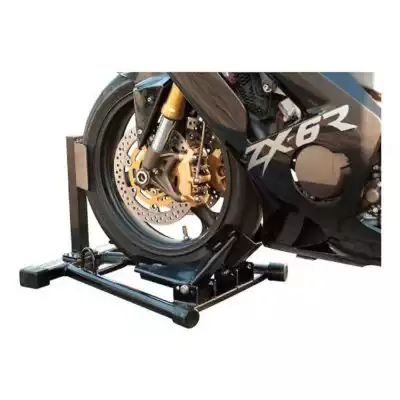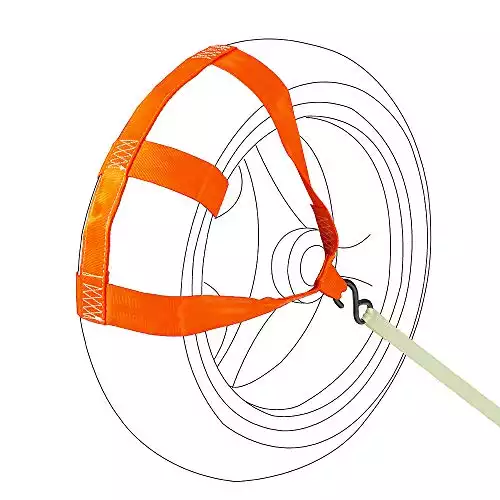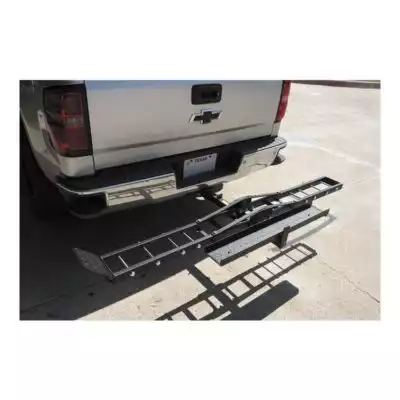There are various reasons why you might want to tow your motorcycle. Going on a road trip in your car but want to take a motorcycle with you, towing a broken down bike, or taking it to the shop for repairs.
Whatever the reason, it’s essential to load and tow your machine safely. In this article, I look at the different methods of towing your motorcycle and give tips on how to do it safely.
Ways to tow your motorcycle
First, I have a lot of experience towing motorcycles on trailers. Having moved multiple times across Europe, I’ve towed my bikes thousands of miles and never had a problem. You need the right equipment; take your time, and it will be fine.
Trailers
Motorcycle trailer
A dedicated motorcycle trailer is probably the safest method of towing your motorcycle. The trailer is designed for this purpose; it will be easy to load and have plenty of good tiedown points.
A motorcycle trailer will have a ramp to make loading your bike easy, plus plenty of easily accessible tiedown points. There are even motorcycle trailers that you can lower for loading so that they are flat on the ground.
More expensive motorcycle trailers will have “wheel chocks” fitted. This device holds the front wheel, keeping the bike upright. All you need to do is ride or push the bike onto it. With a wheel chock, you only need a couple of straps to stop the motorcycle from moving around excessively, although I always recommend using four straps per bike.
Most dedicated motorcycle trailers will have a built-in ramp, which is much easier to use. Without one, you need to carry a piece of wood or a metal ramp to attach to the rear of the trailer.
General purpose trailer
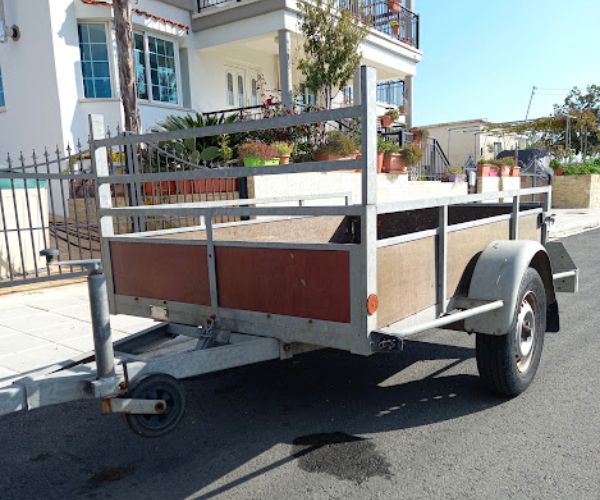
A multi-purpose trailer seems like a great do it all solution, which means your trailer is more practical, but there are some drawbacks.
- The trailer is likely to be higher than a bike trailer, making loading more difficult
- The increased height also puts the center of gravity much higher
- There won’t be any tiedown points designed specifically for motorcycles
- You will usually need a separate ramp to get the bike onto the trailer. See our guide to the best motorcycle loading ramps
The advantages may outweigh the drawbacks;
- A multi-purpose trailer is less likely to be parked unused and take up space
- Cheaper than a dedicated bike trailer
- Able to carry multiple bikes
Despite the above negative points, a general-purpose trailer might be the perfect solution for you. If you are not going to be towing a motorcycle regularly, then the expense of a trailer that can only carry motorcycles is hard to justify.
Also read how to tie down a motorcycle on a trailer without a chock.
Loading a trailer
Loading a trailer is easy, so long as you have a suitable ramp. You need to do it with confidence. I’ve seen people load a motorcycle onto a trailer nervously, get halfway up the ramp, and panic. That is when you are most unstable and likely to drop the bike.
A bit of preparation beforehand helps;
- Attach the trailer to the towing vehicle to prevent the trailer from moving or tipping up
- Make sure the ramp is fitted securely and double-check it
- If there is a wheel chock, make sure it is set to receive the front tire
- Have your straps ready
If you have someone to help, pushing the bike up the ramp is the safest. If not, you’ll likely need to ride the bike up the ramp. This depends on the size and weight of the bike, of course.
It’s a matter of practice, but you need enough speed to get safely up the ramp but not so much that you can’t stop before hitting the end of the trailer. If available, attach two other ramps on either side of the bike ramp. At least then, if something goes wrong, you can put your feet down.
Strapping the motorcycle down
How many straps you need depends on the type of trailer and if you have a wheel chock. With a wheel chock, the bike is securely held and can’t roll back and forth, but you need to stop it from moving from side to side.
There are various accessories to help you strap a motorcycle securely.
Ratchet straps
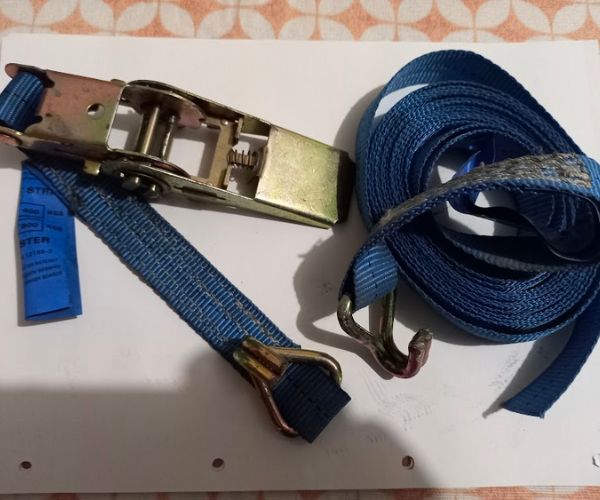
The primary method for strapping your motorcycle down is ratchet straps. Yes, you could use rope, but ratchet straps are much easier and more convenient. It’s vital to use the straps carefully, attaching them to solid points on the bike and ensuring they don’t rub on anything.
The frame, swing arm, and bottom steering yoke are good strap attachment points. Less sturdy are the foot pegs, subframe, and exhaust. A lot of force is put through the strap mounting points, so choose your strapping points carefully.
Handlebar straps
I’ve used these many times and have two in my garage. Handlebar straps fit over the handlebars and have loops on each end. Your ratchet straps thread through the loops and down to the tie-down points.
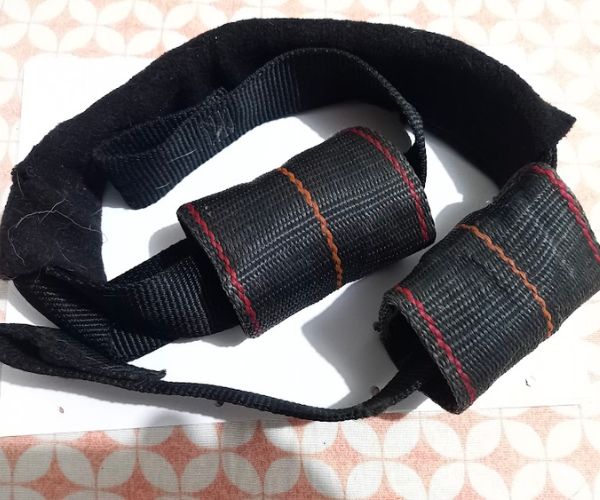
There are two significant advantages of using handlebar straps;
- They provide easily accessible strapping points
- The ratchet straps are well away from the motorcycle, preventing rubbing and damage to your bike.
The only caution is that you cannot strap them down too tightly, as the handlebars may be damaged. Just be careful when tightening the straps.
Tire downs
Tire downs are another handy piece of kit. As with the handlebar straps, they provide easy strapping points and keep the straps away from your motorcycle.
They wrap around the back tire, and you attach your straps. Combined with a front wheel chock, you can get away without additional straps. That said, I would use a strap on each side to prevent side-to-side movement.
Tow dolly
A tow dolly is like a wheel chock but mounted to the back of the towing vehicle. You lift the front wheel onto the dolly and use two straps to secure the bike.
This is a quick and easy way to tow a motorcycle. The dolly is small and light, easily stored when not in use, and they are available to carry up to 800 pounds, making them suitable for even the heaviest bikes.
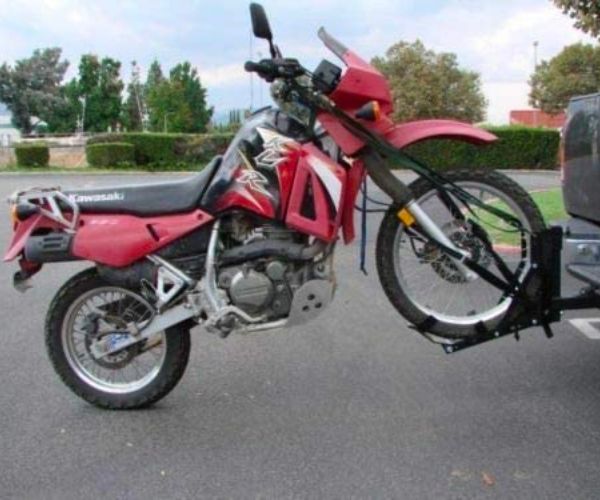
They make an excellent option for short distances, but I’d prefer to use a trailer if I travel far.
Motorcycle carrier
A motorcycle carrier attaches to the tow hitch of your vehicle and is a simple and easy towing method.
There are a couple of things to bear in mind, though. First, all the weight of the motorcycle is on the rear of your vehicle. You’ll need a suitable SUV or truck that can support this weight. Second, you must have the correct type of tow hitch fitted to ensure the carrier is secure.
The motorcycle carrier is an excellent alternative to a trailer, as it’s simpler to load, and you’re not dragging a trailer behind you. Motorcycle carriers can handle up to 600 pounds, which is suitable for all but the heaviest bikes.
To cover or not to cover
Should you cover your motorcycle while towing? I did this once, but never again! We traveled several thousand miles from home in Germany to a friend’s holiday home in Spain. My thought was to protect the bike from getting dirty on the way down.
However, the wind thrashed the cover around, ultimately ripping it and rubbing on the bike’s bodywork. There was no damage that a bit of T-cut and polish couldn’t fix, but I’ve never covered a bike since.
Tow your motorcycle with another bike
The last method of towing a motorcycle is definitely the last resort! Towing a motorcycle with another motorcycle is difficult, but you can do it
You’d only use this method if you broke down somewhere a tow vehicle couldn’t get to, such as out on dirt tracks.
There are two main methods. In both cases, the tow rope must only be tied to the towed motorcycle. I’ll explain in more detail below.
High point to high point
Attach the tow rope between a high point on the towing motorcycle’s rear, and the towed motorcycle’s triple clamp. The advantage of this is that the tow rope is free to move in any direction without interfering with either bike.
You must only wrap the tow rope once around the towing point of the lead motorcycle, and then the free end is held by the rider on the handlebars. In this way, if there is a problem, the rider can release the rope.
Footpeg to footpeg
If there are no suitable towing points for the high-level method, then you can connect the bikes by the footpegs. The disadvantage to this method is that the towed bike is restricted in how far it can maneuver from left to right.
As with the high point method, the tow rope is only wrapped once around the lead bike’s footpeg, and the rider holds the rope with his boot. If there are any problems, the lead rider can quickly release the tow rope.
